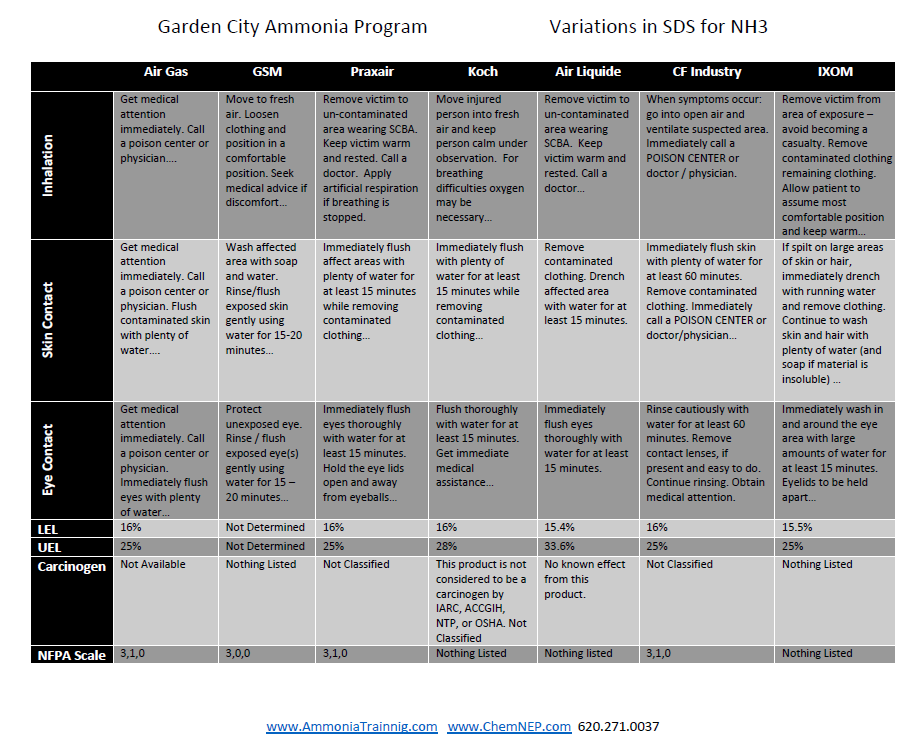A fellow colleague came across an interesting statement in a document from a vendor this last week. What was being researched was the minimum rinse time for decontamination for ammonia exposure and what was discovered was to call Poison Control. Let that sink in a bit. For the United States and all US based RAGAGEP ammonia is not considered a poison, but a toxic. However internationally, it is classified as a poisonous gas.
IIAR states this from the 2008 Ammonia Data Book, “Anhydrous ammonia is classified as non-flammable, nonpoisonous compressed gas (“Class 2 , Division 2.2” hazardous material) for domestic shipments; and gas poisonous by inhalation (“Class 2, Division 2.3” hazardous material) for international shipments.” A recent search online found that most dictionaries will say that toxic and poisonous are synonyms, however there are many articles that say they are not. Regardless of your classification of the chemical, we all still must know the adherent dangers of it when exposed to humans.
Since Joseph Priestley first isolated ammonia till present day, the industry respected vendors/manufactures/distributors/experts still have lack of understanding or united agreement in regards to the chemical. There is still today such a wide range of the science behind such a simple chemical. What is also so unique is how so much of the data that was in the old MSDS and now either lacks or has been changed since the SDS generation has evolved. Look at these two published documents from the same vendor. Going from MSDS to SDS could not of changed the chemical, so why has so much changed about and regards to the chemical in the two data sheets? A recent conversation with a cooperate PSM manager on this subject was debating the thoughts that moving into the new HAZCOM requirements has reversed the known knowledge made available to meet international requirements of the revamped HAZCOM standard.
For example, some want you to call poison control when exposed, however poison control will tell you to decontaminate with large amounts of water and seek medical help. Some don’t know if it will cause cancer and others say studies says it will not. Some don’t know the flammability limits, while other have a wide range compared to others. Why is there so much unknown in these published data sheets in 2018. Should we expect more?
I chose to call poison control this last to see what they would say to me when I tell them I have a person exposed to anhydrous ammonia. Their response on the phone was, “to decontaminate and large quantities of continuous water.” I eventually had the opportunity to talk to Tama Sawyer whom is the managing director of Poison Control Center. I asked her if I may have a written statement from poison control of what should be the life safety order of an event of somebody getting ammonia on them. This is her response, “I do believe that decontamination should start immediately, but contacting the Poison Control Center as soon as possible is also very important. As you know anhydrous ammonia can cause frost bite and you can’t just rinse for a minute or two. We would want to make sure that thorough decontamination has taken place. We also contact the closest health care facility to give them not only the heads up but also recommendations on further treatment of the patient.” GCAP highly encourages you to understand your chemical and not rely on sole data from one SDS sheet. Please do not build safety programs that will call poison control first when a person is exposed to ammonia as well. Tama sent over a PDF from ATSDR that has some also know information on ammonia that could be a great addition to any safety program.
Below is a quick example of the various levels of information from various SDS that cover the same chemical. There are now so many Variations in the SDS for NH3, you may want to seek more advise on your chemical than just the SDS! It is quite shocking that today we still seek to understand what we thought we already knew.


